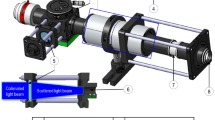Abstract
The strain and stress state in the chip formation zone determines the chip formation. However, it is difficult to obtain experimental data about the strain/stress fields during machining. For this reason, present chip formation models highly simplify the chip formation process. In order to extend the knowledge regarding the chip formation mechanisms, an experimental method for the in situ measurement of the elastic deformations within the chip formation zone during the cutting process has been developed. Using these deformations, the stress state can subsequently be calculated. The method is based on X-ray diffraction using high-energy synchrotron X-radiation during machining the workpiece in an orthogonal cutting process under quasistatic experimental conditions. The diffraction patterns are captured with a 2D detector. A comparison of the experimentally determined stresses at different measuring positions within the chip formation zone with results from a FEM cutting simulation shows a good qualitative and partially also quantitative consistency. Possibilities for the further performance increase of the method are identified so that the method can be used for the verification and extension of existing chip formation models in future.






Similar content being viewed by others
References
Ernst HJ, Merchant ME (1941) Chip formation, friction and finish. Trans ASME 29:299
Opitz H, Hucks H (1953) Der Zerspanungsvorgang als Problem der Mohr’schen Gleitflächentheorie für den zwei- und dreiachsigen Spannungszustand. Werkstattstechnik und Maschinenbau 6:253–260
Warnecke G (1974) Spanbildung bei metallischen Werkstoffen. Technischer Verlag Resch KG, Gräfelfing
Gnanamanickam E, Huang C, Murthy TG, Sullivan JP, Chandrasekar S (2009) In situ measurement of deformation and temperature in machining. In: Proceedings of the 12th CIRP conference on modelling of machining operations, pp 383–394
Oxley PLB (1989) Mechanics of machining, an analytical approach to assessing machinability. Ellis Horwood Limited, Chichester
Martins RV (2008) Residual stress analysis by monochromatic high-energy X-rays. In: Reimers W, Pyzalla AR, Schreyer A, Clemens H (eds) Neutrons and synchrotron radiation in engineering materials science. Wiley-VCH, Darmstadt, pp 177–194
Reimers W (2008) Indroduction to diffraction methods for internal stress analysis. In: Reimers W, Pyzalla AR, Schreyer A, Clemens H (eds) Neutrons and synchrotron radiation in engineering materials science. Wiley-VCH, Darmstadt, pp 115–135
Uhlmann E, Herter S, Gerstenberger R, Roeder M (2009) Quasi-static chip formation of intermetallic titanium aluminides. Prod Eng Res Dev 3(3):261–270
He BB (2009) Two-dimensional X-ray diffraction. Wiley, Hoboken
Uhlmann E, Mattes A, Graf von der Schulenburg M, Gerstenberger R (2009) Investigations on the adjustment of the modelling section in 2D simulations of milling processes. Int J Mach Machinability Mater 6(1/2):69–82
Issler L, Ruoß H, Häfele P (2003) Festigkeitslehre–Grundlagen. Springer, Berlin
Kröner E (1958) Berechnung der elastischen Konstanten des Vielkristalls aus den Konstanten des Einkristalls. Zeitschrift für Physik 151:504–518
Eshelby JP (1957) The determination of the elastic field of an ellipsoidal inclusion and related problems. Proc R Soc A 241:376–396
Bunge HJ (1969) Mathematische methoden der texturanalyse. Akademie-Verlag, Berlin
Hall EO (1951) The Deformation and Ageing of Mild Steel: III Discussion of Results. Proc Phys Soc 64(9):747–752
Author information
Authors and Affiliations
Corresponding author
Rights and permissions
About this article
Cite this article
Uhlmann, E., Gerstenberger, R., Herter, S. et al. In situ strain measurement in the chip formation zone during orthogonal cutting. Prod. Eng. Res. Devel. 5, 1–8 (2011). https://doi.org/10.1007/s11740-010-0266-x
Received:
Accepted:
Published:
Issue Date:
DOI: https://doi.org/10.1007/s11740-010-0266-x




